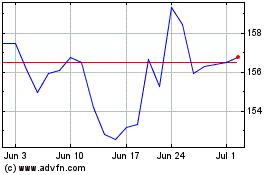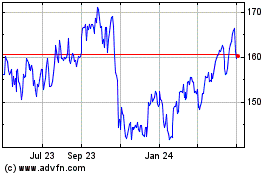Investors grow leery of free-spending firms, preferring the
discipline seen at ConocoPhillips
By Bradley Olson
This article is being republished as part of our daily
reproduction of WSJ.com articles that also appeared in the U.S.
print edition of The Wall Street Journal (April 3, 2018).
Big oil is starting to think small.
Once defined by massive spending and ambitious exploration, some
of the world's biggest energy companies have begun to preach
frugality. Investors increasingly favor producers that promise to
increase cash payouts, rather than boosting spending to drill for
more oil.
The best-performing major U.S. oil producer by share price
increase in the past year isn't Exxon Mobil Corp. or Chevron Corp.,
but ConocoPhillips, a company that has reduced its size and
prioritized share buybacks and dividends over growth in recent
years. Its shares have risen 29%, beating the S&P 500 and
significantly outperforming the company's U.S. rivals. Shares of
Exxon, which recently laid out plans to increase spending by 25% or
more beginning in 2020, have fallen by about 9% in that time.
The success of ConocoPhillips suggests that investors are
looking for something different from big oil companies these days.
Fading are the days when shareholders bought Exxon or Chevron to
get exposure to the big profits that could come with rising oil
prices, while being insulated somewhat from falling prices through
running refineries and petrochemical plants.
An increasing number of investors want conservative, stable
returns -- not unlike why some look to the utility industry.
"The oil-and-gas industry is on its way to transitioning to a
more mature market in the U.S.," said Tim Beranek, who helps manage
more than $18 billion in assets for Cambiar Investors. "Over the
last decade, with the evolution of shale, it was an emerging
industry and attracted a lot of growth investors. Now, the
shareholder base just wants return on capital."
As surging U.S. crude production continues to threaten price
rallies with new supply, investors have become far more skeptical
about growth. Instead, the push for cash is catching on.
Beginning in 2012, ConocoPhillips, once among the world's
biggest oil companies, started to make this transition. It spun off
its refining business, closed its deepwater exploration unit, and
chose to distribute more of its free cash flow to shareholders
rather than reinvesting it.
Few oil chieftains at the time were moving in that direction. It
was "a pretty lonely place," said Ryan Lance, ConocoPhillips' chief
executive, in an interview.
The strategy was shaped by a view that surging U.S. oil output
would create a new era of uncertainty. American oil production
recently topped 10 million barrels a day, breaking a prior U.S.
record set in 1970.
"The cycles are getting shorter, from peak to peak and trough to
trough, " Mr. Lance said. Instead of "chasing the cycles up and
down," he said, ConocoPhillips has focused on its "sustaining
capital" -- the oil price it needs to keep production flat and pay
for dividends and new investments.
The company's "sustaining" price is now $40 a barrel, Mr. Lance
said, which means that with U.S. crude selling for more than $60 a
barrel, much of the excess can go to shareholders.
While other companies have boosted share buybacks and dividends,
few have as low a sustaining price. Many are turning to asset sales
in order to balance new spending and cash-return plans with the
funds they receive from operations. For example, Hess Corp.
increased its buyback program by $1 billion in March, avoiding a
proxy fight with an activist shareholder.
The company is expected to generate about $1.6 billion from
operations, according to analyst estimates on FactSet. With $2.1
billion in spending planned for 2018, that equates to a cash
deficit of $1.5 billion. Hess sold more than $3 billion in assets
last year. Hess executives have said they plan to reach a point
where they will generate enough cash to pay for new investments by
2020.
Exxon and Chevron, which are much larger than ConocoPhillips and
have far higher profits, also have longstanding dividends that
neither company cut since oil plunged in 2014. The companies also
had a long history of buying back billions of dollars of their
shares, but Chevron suspended its program in 2015 and Exxon's was
scaled back significantly. Chevron is expected to resume its
buyback program soon.
The recent run of ConocoPhillips hasn't been without challenges.
Once among the industry's biggest dividend payers, the company cut
the payout by about two-thirds in early 2016 as oil prices fell to
less than $30 a barrel. It argues that this is all part of its
cash-management strategy. While oil prices rise, it returns the
bounty to investors, but when prices fall below the sustaining
price, it can sell assets, cut dividends or increase debt.
Crude prices are up by about 26% in the past six months, but
unlike in the past, oil equities haven't followed, suggesting that
some investors lack confidence in the price rally.
In this climate, shareholders are likely to prefer producers
like ConocoPhillips that demonstrate frugality, said Doug Terreson,
an energy analyst at Evercore ISI who has championed greater
discipline in oil.
"One of the key concerns in the industry is that companies are
growing more disciplined today, but if the oil price rises, they
will increase spending," he said.
Write to Bradley Olson at Bradley.Olson@wsj.com
(END) Dow Jones Newswires
April 03, 2018 02:47 ET (06:47 GMT)
Copyright (c) 2018 Dow Jones & Company, Inc.
Chevron (NYSE:CVX)
Historical Stock Chart
From Mar 2024 to Apr 2024

Chevron (NYSE:CVX)
Historical Stock Chart
From Apr 2023 to Apr 2024
